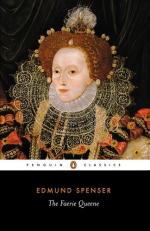Examples of his use of classical constructions are: the ablative absolute, as, which doen (IV, xliii); the relative construction with when, as, which when (I, xvii), that when (VII, xi); the comparative of the adjective in the sense of “too,” as, weaker (I, xlv), harder (II, xxxvi); the participial construction after till, as, till further tryall made (I, xii); the superlative of location, as, middest (IV, xv); and the old gerundive, as, wandering wood (I, xiii). Most of the gallicisms found are anglicized loan words from the French romans d’aventure, such as, disseized, cheare, chappell, assoiled, guerdon, palfrey, recreaunt, trenchand, syre, and trusse. Notwithstanding Spenser’s use of foreign words and constructions, his language is as thoroughly English in its idiom as that of any of our great poets.
“I think that if he had not been a great poet,” says Leigh Hunt, “he would have been a great painter.”
“After reading,” says Pope, “a canto of Spenser two or three days ago to an old lady, between seventy and eighty years of age, she said that I had been showing her a gallery of pictures. I do not know how it is, but she said very right. There is something in Spenser that pleases one as strongly in old age as it did in youth. I read the Faerie Queene when I was about twelve, with infinite delight; and I think it gave me as much, when I read it over about a year or two ago.”
The imperishable charm of the poem lies in its appeal to the pure sense of beauty. “A beautiful pagan dream,” says Taine, “carries on a beautiful dream of chivalry.” The reader hears in its lines a stately and undulating rhythm that intoxicates the ear and carries him on with an irresistible fascination, he sees the unsubstantial forms of fairyland go sweeping by in a gorgeous and dreamlike pageantry, and he feels pulsing in its luxuriant and enchanted atmosphere the warm and beauty-loving temper of the Italian Renaissance. “Spenser is superior to his subject,” says Taine, “comprehends it fully, frames it with a view to the end, in order




